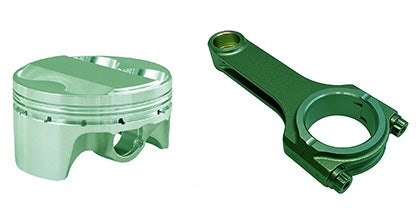Mitsubishi 4G63 Engine Guide
There were two main families of 4g63 engine. The early model 6-bolt engine, and the later model 7 bolt engine. But within those two families there were even more variations. This document will outline the differences you need to know when selecting parts and building your engine. These names come from the number of flywheel bolts that hold the flywheel onto the crankshaft. Both the 6-Bolt and 7-Bolt were 2.0L displacement with 85mm bore, 150mm rod length, and 88mm stroke. There is only one type of 6-bolt 4G63, but there are a number of differences between different years of 7-Bolt 4G63 so we will outline them below.
Table of Contents
- Engine Info & Parts Interchangeability
- 6-Bolt 4G63T (1G DSM & GVR4)
- 7-Bolt 4G63T (1G DSM)
- 7-Bolt 4G63T (2G DSM & EVO1-3)
- 7-Bolt 4G63T (Evo 4-8)
- 7-Bolt 4G63T (Evo 9 w/ MIVEC)
- Displacement Combinations (2.0L, 2.0L Long Rod, 2.1L Stroker, 2.1L Long Rod Stroker, 2.3L Stroker)
6-Bolt 4G63T
6-Bolt 4G63T (1G DSM)
- 1990-1993.5 Mitsubishi Eclipse Turbo GST (FWD) & GSX (AWD)
- 1990-1993.5 Eagle Talon TSi Turbo (FWD & AWD)
- 1990-1993.5 Plymouth Laser RS Turbo (FWD & AWD)
- 1992-1992 Mitsubishi Galant VR4
- Bore Diameter: 85mm
- Rod Length: 150mm
- Stroke: 88mm
- Head cc: 49cc
- Stock Compression Ratio: 7.8:1
6-Bolt 4G63T Parts Interchangeability
Pistons
- The 6-Bolt 4G63 engine has less aftermarket support than the newer 7-Bolt 4G63 so there are fewer piston options. You CAN use 7-Bolt pistons in a 6-bolt engine, however because the 7-Bolt pistons use a 22mm wrist pin and the 6-Bolt pistons use a 21mm wrist pin, you will either have to customize the 6-Bolt connecting rod to use a 22mm wrist pin, or you will have to purchase a "conversion rod" that is designed to use a 22mm pin on a 6-Bolt connecting rod.
Connecting Rods
- You cannot use 7-Bolt connecting rods in a 6-Bolt engine because the rod journal on the crankshafts is different, however you can purchase specially-built connecting rods for the 6-Bolt that come with a 22mm pin bushing so you can use 7-Bolt pistons in your 6-Bolt engine.
Connecting Rod Bearings
- All of the 6-Bolt 4G63 engines use the same connecting rod bearings. You cannot use 6-Bolt rod bearings in a 7-Bolt engine, and you cannot use 7-Bolt rod bearings in a 6-Bolt engine.
Main Bearings
- All of the 6-Bolt 4G63 engines use the same main bearings. You cannot use 6-Bolt main bearings in a 7-Bolt engine, and you cannot use 7-Bolt main bearings in a 6-Bolt engine.
Crankshafts
- You cannot use a 7-Bolt crankshaft in a 6-Bolt block. And you cannot use a 6-Bolt crank in a 7-Bolt block.
Oil Pumps
- The 6-Bolt 4G63 engine has it's own oil pump and you cannot use a 7-Bolt oil pump on a 6-Bolt Block.
Water Pumps
- The 6-Bolt 4G63 engine has it's own water pump and you cannot use a 7-Bolt water pump on a 6-Bolt Block.
Camshafts
- The camshafts are interchangeable between the 6-Bolt 4G63 engines and the early 7-Bolt 4g63 engines that came in the 2G DSM and the Evo 1-3, but you cannot use Evo 4-8 or Evo 9 camshafts in a 6-bolt 4G63 head.
Valves
- The valves can be interchanged between all of the 4G63 engines (6-Bolt and all of the 7-Bolt variations as well)
7-Bolt 4G63T
7-Bolt 4G63T (1G DSM)
- 1993.5-1994 Mitsubishi Eclipse Turbo GST (FWD) & GSX (AWD)
- 1993.5-1994 Eagle Talon TSi Turbo (FWD & AWD)
- 1993.5-1994 Plymouth Laser Esi Turbo (FWD & AWD)
- Bore Diameter: 85mm
- Rod Length: 150mm
- Stroke: 88mm
- Head cc: 49cc
- Stock Compression Ratio: 8.5:1
7-Bolt 4G63T (2G DSM & EVO1-3)
- 1995-1998 Mitsubishi Eclipse Turbo GST (FWD) & GSX (AWD)
- 1995-1998 Eagle Talon TSi Turbo (FWD & AWD)
- 1992-1996 Mitsubishi Lancer Evo1-3
- Bore Diameter: 85mm
- Rod Length: 150mm
- Stroke: 88mm
- Head cc: 47cc
- Stock Compression Ratio: 8.5:1
- 1997-2005 Mitsubishi Lancer Evo 4-8
- Bore Diameter: 85mm
- Rod Length: 150mm
- Stroke: 88mm
- Head cc: 43cc
- Stock Compression Ratio: 8.8:1
- 2006 Mitsubishi Lancer Evo 9
- Bore Diameter: 85mm
- Rod Length: 150mm
- Stroke: 88mm
- Head cc: 43cc
- Stock Compression Ratio: 8.8:1
7-Bolt 4G63T Parts Interchangeability
Pistons
- The same pistons can be used between all of the 7-Bolt 4G63 engines from 1994-2006 however, because the cylinder heads changed between DSM and Evo, the resulting compression ratio will work out to be higher in the Evo than a DSM using the same piston. For example, a stock-replacement piston with a -14cc dish in the top of the piston will make a 9.0:1 compression ratio in an Evo, but that same piston in a DSM will come out to 8.5:1 because the Evo head has a smaller combustion chamber.
Connecting Rods
- All of the 7-Bolt 4G63 engines use the same connecting rods, but you cannot use a 7-Bolt connecting rod in a 6-Bolt 4G63 engine because the diameter of the rod journal is different, and the wrist pin diameter is different (6-Bolt = 21mm pin, 7-Bolt = 22mm pin).
Connecting Rod Bearings
- All of the 7-Bolt 4G63 engines use the same connecting rod bearings.
Main Bearings
- Here is where things start to get tricky. 1997 was a "split year" in the 7-Bolt 4G63T. So all of the 7-Bolt engines all the way up until the middle of 1997 came with main bearings that had an integrated thrust washer built into them. In the June 1997, they changed the main bearing style over to a separate main bearing and thrust washer.
Crankshafts
- All of the 7-Bolt 4G63 engines use the same crankshafts, but you cannot use a 6-Bolt 4G63 crankshaft in a 7-Bolt 4G63 engine.
Oil Pumps
- There are two types of oil pumps for the 7-Bolt 4G63, there is one that works on the 7-Bolt 4G63 engines that came in the 2G DSM and Evo1-3 and then there is another oil pump for the Evo 4-9. The easy way to remember this is basically that the oil pump changed when the engine started mounting on the passenger side of the engine bay.
- 2G DSM & Evo 1-3 use one oil pump
- Evo 4-9 use a different oil pump.
Water Pumps
- There are different water pumps for each generation of 7-Bolt 4G63
- 2G DSM has it's own water pump.
- Evo 4-7 has it's own water pump.
- Evo 8 has it's own water pump.
- Evo 9 has it's own water pump.
Camshafts
- There are three different kinds of camshafts for the 7-Bolt 4G63 that are not interchangeable
- The 2G DSM and Evo 1-3 had one style of camshaft (same as the 6-Bolt 4G63)
- The Evo 4-8 have their own camshafts
- The Evo 9 has its own specific camshafts because of the addition of MIVEC variable cam timing.
Valves
- The valves can be interchanged between all of the 4G63 engines (6-Bolt and all of the 7-Bolt variations as well)
Displacement Configurations:
There are 4 popular displacement configurations for the 4G63. There are more than 4 configurations however, these are the 4 that manufacturers make shelf parts for. So you can build them without needing custom parts.
| 2.0L Standard | 2.0L Long Rod | 2.1L Stroker | 2.1 Long Rod Stroker | 2.3L Stroker | |
| Compression Height | 34.7mm - 35mm | 28.7mm - 28.8mm | 31.7mm - 31.9mm | 25.7mm - 25.9mm | 28.7mm - 28.8mm |
| Rod Length | 150mm (Std) | 156mm | 150mm (Std) | 156mm | 150mm (Std) |
| Stroke | 88mm (Std) | 88mm (Std) | 94mm | 94mm | 100mm |
| Rod/Stroke Ratio | 1.70 | 1.77 | 1.60 | 1.66 | 1.50 |
Each one of these combinations as a different Rod Length, Stroke, and Compression Height combination that all add up to a dimension that will fit within the 4g63 block.
Some people want a bigger engine with more displacement, while others want a higher rod/stroke ratio for longevity at high rpm.
2.0L Standard Dimensions
The factory 4g63 came with an 88mm stroke, and 150mm rod length, and a 34.9mm piston compression height. There are lots of pistons, rods, and crankshafts that stick to these standard dimensions and some of the fastest 4g63 cars in the world have set records using the factory dimensions. The rod/stroke ratio is 1.7 in factory configuration which is pretty good.
2.0L "Long Rod"
This configuration uses a standard stroke (88mm) crank, a rod length that is longer than stock (156mm vs 150mm), and a piston compression height that is shorter than stock to make up for the added rod length. This combination still works out to a 2.0L displacement, however the rod/stroke ratio goes up from 1.70 to 1.77. This means that the connecting rod see's less of an angle as the crankshaft rotates which, in theory, means less side-loading friction on the piston. It is commonly believed that this leads to better longevity at higher rpm. We commonly see people go the long-rod route when building drag engines that will spend most of their lives operating in high rpm wide-open-throttle events.
2.1L "Stroker"
This configuration uses a crankshaft with a larger-than-stock stroke (94mm vs 88mm) crank, a standard rod length (150mm), and a piston compression height that is shorter than stock to make up for the added stroke. This combination works out to a 2.1L displacement, however the rod/stroke ratio goes down from the factory 1.70 to 1.60. A lower rod/stroke ratio typically creates a powerband with more torque in the bottom end however this is not the lowest rod/stroke ratio configuration in the 4g63 shelf lineup.
2.1L "Long Rod Stroker"
This configuration uses a crankshaft with a larger-than-stock stroke (94mm vs 88mm) crank, a longer-than-stock-length rod (156mm vs 150mm), and a piston compression height that is shorter than stock to make up for the added stroke and rod length. This combination works out to a 2.1L displacement, however the rod/stroke ratio is very close to the standard 1.70 at 1.66. This configuration was created as a solution to slightly increase the displacement of the engine without seriously changing the rod/stroke ratio. This engine has a taller-than-stock stroke, and a longer-than-stock rod but maintains ALMOST the same rod/stroke ratio as teh factory.
2.3L "Stroker"
This configuration uses a crankshaft with a larger-than-stock stroke (100mm vs 88mm) crank, a standard rod length (150mm), and a piston compression height that is shorter than stock to make up for the added stroke. This combination works out to a 2.3L displacement, however the rod/stroke ratio goes down from the factory 1.70 all the way down to 1.50. This is the lowest rod/stroke ratio you can get with shelf-parts in a 4g63. This combination is usually the go-to setup for street cars that want torque down low for drivability and response. The low rod/stroke ratio and the added displacement make this an ideal setup for low-rpm street cars. The factory transmission in 4g63 vehicles don't like shifting at high rpm, and you typically have to build the transmission to shift consistently at high rpm without breaking. So if you are looking to build a high reving engine, be ready ot build a transmission to go with it. This is why many people go with the 2.3L Stroker setup because they can make a lot of power with an engine that responds quickly on the street and doesn't have to rev so high that the transmission begins struggling to shift consistently without breaking. Because of the rod angle caused by the low rod stroke ratio, these engines can wear prematurely if you regularly rev them higher than about 8000rpm.








